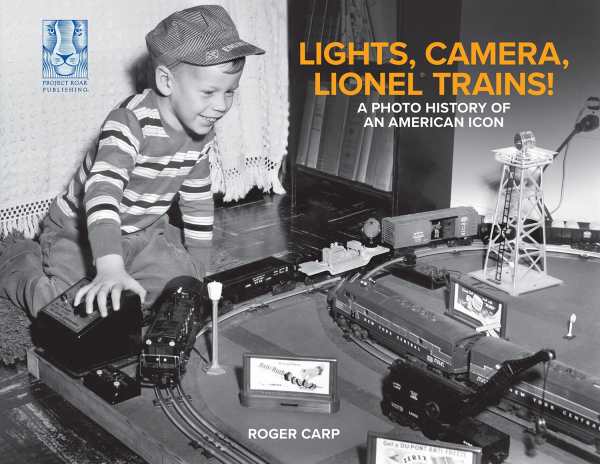Lights, Camera, Lionel Trains!
A Photo History of an American Icon
- 2024 INDIES Finalist
- Finalist, Popular Culture (Adult Nonfiction)
Lights, Camera, Lionel Trains! is a varied visual mosaic that illustrates the breadth and depth of the toy trains’ cultural impact.
Roger Carp’s lavish coffee table book Lights, Camera, Lionel Trains! is a panoramic photographic history of the iconic model railroad that captivated generations.
The book takes a nostalgic look at the electric toy train, recounting its expansive history via more than one hundred photographic essays that ruminate on how Lionel trains played into people’s childhoods, popular culture, and society at large. The images depict Lionel trains on living room floors, in basements, on magazine covers, in advertisements, in catalogs, and in department store displays. Children, model railroad club members, and celebrities including Joe DiMaggio and Rita Hayworth are shown interacting with the trains. The result is a varied visual mosaic that illustrates the breadth and depth of the trains’ cultural impact.
Every photograph tells a story, from promotional images culled from mass-circulation magazines to intimate moments from vintage family collections that have never before seen publication. The often black-and-white photographs capture joy, wonder, amazement, and a sense of play, conveying the emotional freight of the trains. While the shots of children beaming while hunched over model train tracks get repetitive, the selections are otherwise judicious. There are stunning images of the crammed, fluorescent-lit back room of a hobby shop; an aerial shot of Lionel executives sitting around a round table tinkering with train cars while smoking cigarettes; and the “fantasy land” of the Spoonley the Train Man showroom.
Each photograph has a full page, ensuring visual impact. Each is twinned with a page-long essay that explains and contextualizes some aspect of Lionel trains, such how a photograph in Life magazine of the civil rights icon and Supreme Court Justice Thurgood Marshall changed public perceptions of him. Product launches, as of the Super O three-rail track, are covered, and information about how the trains appeared on local television shows and how movie theaters used electric trains to promote films like Strangers on a Train is shared. Broad and expansive, the essays convey corporate history, personal significance, and how magazines often would photograph fathers and sons playing with Lionel trains together for Christmas issues. Even subjects like the work of development engineers and the addition of a smoke feature are handled with depth.
Both a homage to and a history of Lionel trains, the nostalgic coffee table book Lights, Camera, Lionel Trains! celebrates the beloved brand and the fond childhood memories it fed into.
Reviewed by
Joseph S. Pete
Disclosure: This article is not an endorsement, but a review. The publisher of this book provided free copies of the book and paid a small fee to have their book reviewed by a professional reviewer. Foreword Reviews and Clarion Reviews make no guarantee that the publisher will receive a positive review. Foreword Magazine, Inc. is disclosing this in accordance with the Federal Trade Commission’s 16 CFR, Part 255.

